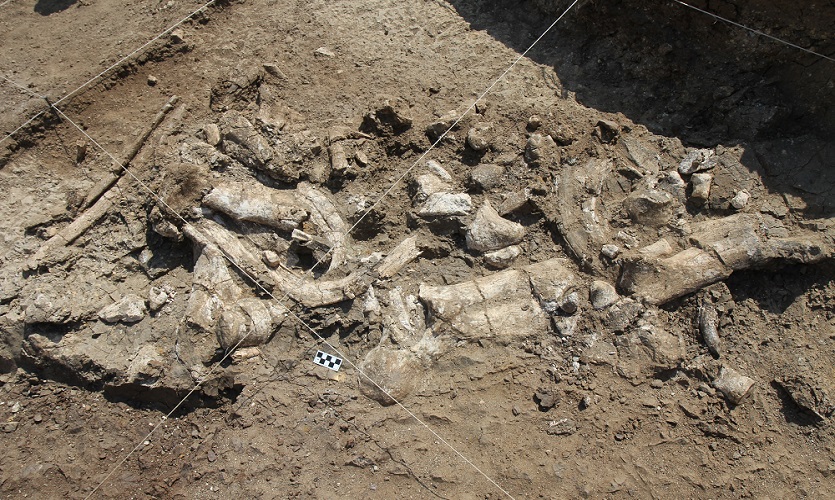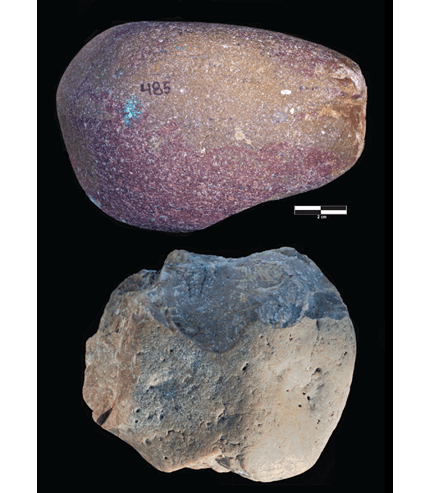Early humans were using stone tools three million years ago

Early humans were using tools to prepare food three million years ago, according to a new study published today (February 9, 2023).
Scientists have unearthed fossil ‘butchery’ or ‘kitchen’ sites near Lake Victoria in Southern Kenya, where our early relatives used stone tools to cut and pound meat and plants.
They are the oldest discovered “pebble tools”, also known as Oldowan tools, by some 300,000 years, and were found alongside the oldest known fossils of Paranthropus, a human ancestor species from the early Pleistocene period.
Professor Laura Bishop, of the Research Centre in Evolutionary Anthropology and Paleoecology at Liverpool John Moores University, UK, who has worked in the region with teams from the Smithsonian Institution, Queens College CUNY and the National Museums of Kenya, said: “This is an amazing find and shows the story of human evolution and behaviour is full of surprises.
“We reconstructed the environmental settings and showed that the tools were used to process plant and animal materials. There’s even direct evidence that the tools were used to butcher hippo and bovine carcasses, the earliest evidence of this behaviour.”
Though multiple lines of evidence suggest the artefacts are likely to be about 2.9 million years old, the artefacts can be more conservatively dated to between 2.6 and 3 million years old, said lead study author Thomas Plummer of Queens College, research associate in the scientific team of the Smithsonian’s Human Origins Program.
Whose tools?
Excavations on Kenya’s Homa Peninsula – at a site called Nyayanga - also produced a pair of massive molars belonging to Paranthropus – the species which pre-dates the first known appearance of the genus Homo. The teeth are the oldest fossilized Paranthropus remains yet found, and their presence at a site loaded with stone tools raises intriguing questions about which human ancestor made those tools.
Explained Professor Bishop: “The evidence directly associates Paranthropus with the tools, and this challenges the more traditional narrative that Oldowan technology appeared with the arrival of early Homo, who were our direct ancestors. The relatively archaic fauna from the site were our first clue that it was relatively ancient, and that has since been confirmed by laboratory dating methods.”
Whichever hominin lineage was responsible for the tools, they were found more than 800 miles from the previously known oldest examples of Oldowan stone tools—2.6-million-year-old tools unearthed in Ledi-Geraru, Ethiopia. This greatly expands the area associated with Oldowan technology’s earliest origins. Further, the stone tools from the site in Ethiopia could not be tied to any particular function or use, leading to speculation about what the earliest uses might have been.

Through analysis of the wear patterns on the stone tools and animal bones discovered at Nyayanga, the team behind this latest discovery shows that these stone tools were used by early human relatives to process a wide range of materials and foods, including plants, meat and even bone marrow.
The research was led by the Smithsonian’s National Museum of Natural History and Queens College, City University New York, and involved six scientists with links to Liverpool John Moores University as well as researchers from the National Museums of Kenya, and institutions in the USA, France, Italy and China.
The Oldowan toolkit includes three types of stone tools: hammerstones, cores and flakes. Hammerstones can be used for hitting other rocks to create tools or for pounding other materials. Cores typically have an angular or oval shape, and when struck at an angle with a hammerstone, the core splits off a piece, or flake, that can be used as a cutting or scraping edge or further refined using a hammerstone.
“With these tools you can crush better than an elephant’s molar can and cut better than a lion’s canine can,” said Rick Potts, senior author from the Smithsonian.
“Oldowan technology was like suddenly evolving a brand-new set of teeth outside your body, and it opened up a new variety of foods on the African savannah to our ancestors.”
Eight years of excavations
Beginning in 2015, a series of excavations at Nyayanga returned a trove of 330 artifacts, 1,776 animal bones and the two hominin molars identified as belonging to Paranthropus.
Project lead Professor Tom Plummer said the toolkit was clearly part of the stone-age technological breakthrough and later spread all the way across Africa and as far as modern-day Georgia and China, and it was not meaningfully replaced or amended until some 1.7 million years ago when the hand-axes of the Acheulean first appeared.
As part of their study, the researchers conducted microscopic analysis of wear patterns on the stone tools to determine how they were used, and they examined any bones seen to exhibit potential cut marks or other kinds of damage that might have come from stone tools. The site featured at least three individual hippos.
Two of these incomplete skeletons included bones that showed signs of butchery. The team found a deep cut mark on one hippo’s rib fragment and a series of four short, parallel cuts on the shin bone of another. Plummer said they also found antelope bones that showed evidence of hominins slicing away flesh with stone flakes or of having been crushed by hammerstones to extract marrow.
The analysis of wear patterns on 30 of the stone tools found at the site showed that they had been used to cut, scrape and pound both animals and plants.
Because fire would not be harnessed by hominins for another 2 million years or so, these stone toolmakers would have eaten everything raw, perhaps pounding the meat into something like a hippo tartare to make it easier to chew.
Concluded Prof Plummer: “This study offers a snapshot of the world humans’ ancestors inhabited and helps illustrate the ways that stone technology allowed these early hominins to adapt to different environments and, ultimately, give rise to the human species.”
This research was supported by funding from the Smithsonian, the Leakey Foundation, the National Science Foundation, the Wenner-Gren Foundation, the City University of New York, the Donner Foundation and the Peter Buck Fund for Human Origins Research.
Images:
Top: Hippo remains at Nyayanga.
Middle: Examples of the 'Oldowan' or 'Pebble' tools found at Nyayanga.


